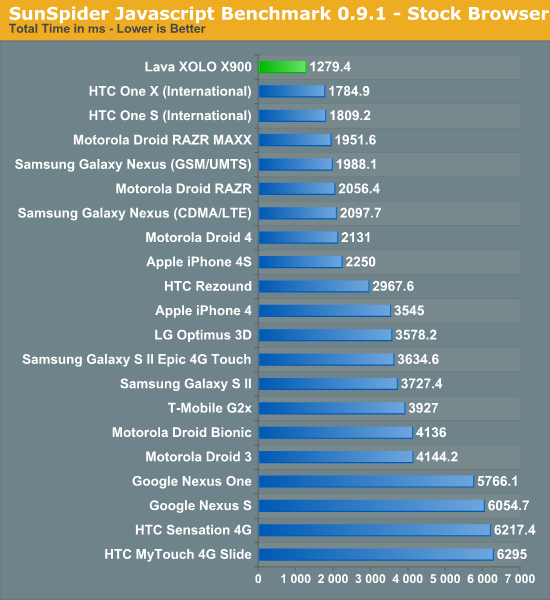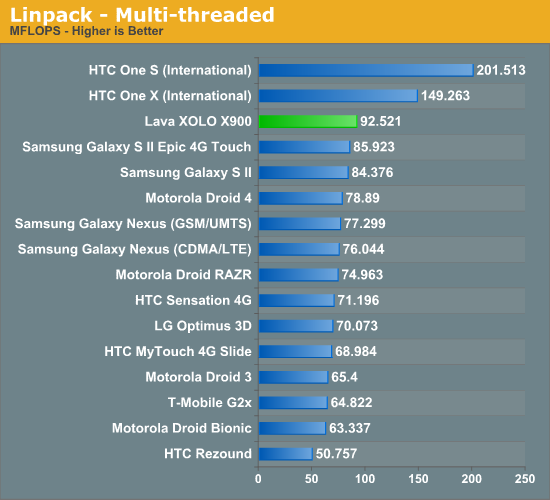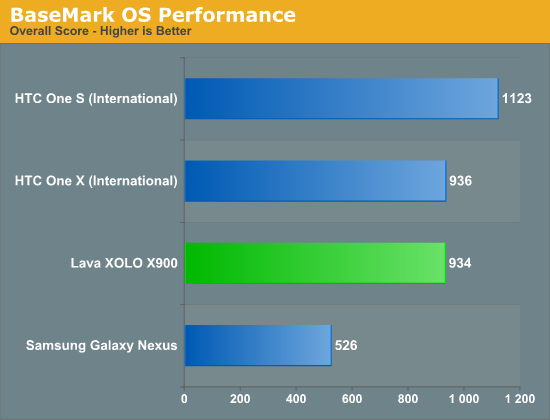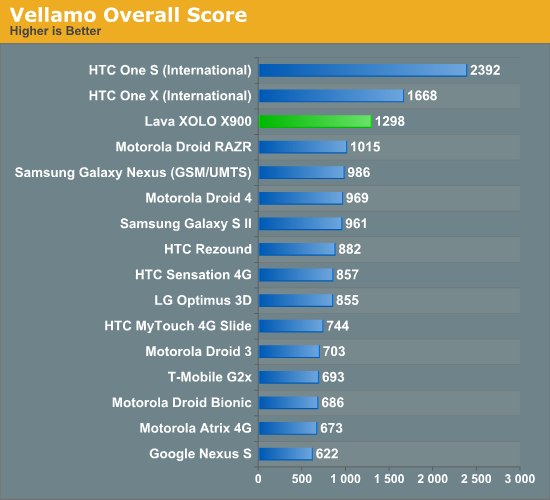Lava Xolo X900 Review - The First Intel Medfield Phone
by Brian Klug on April 25, 2012 6:00 AM ESTJavascript Performance
Although smartphones are clearly headed for a life beyond simple messaging, web browsing and phone duties, we are still lacking the tools to measure performance in areas other than a component of web page rendering. Measuring javascript performance is one component of the entire web page rendering process but it's the most mature in terms of something we can benchmark.
Sunspider is quite possibly the most well known of these javascript tests, and it also happens to be one that runs extremely well on Medfield:

The Lava phone is just a tad faster than the FFRD we tested at the beginning of the year, which may not sound like much but is positive given that Mike Bell was very confident that all Intel FFRD phones would deliver the same level of performance. The X900 ends up being the fastest smartphone we've ever tested here. Intel won't be able to claim that title in any other benchmark here today but it's an impressive feat for just now showing up to the game. It's also worth pointing out that Intel is able to do this well running on Gingerbread, while its closest competition are running on Ice Cream Sandwich with far improved JS performance built into the browser.
Why is Medfield so much faster here? It's tough to say, but likely a combination of reasons. Google's V8 engine has had a ton of optimization work done around x86 to begin with. By virtue of nearly every computing platform that runs a Google browser outside of Android being x86, it's natural that some of those optimizations are going to transition over into Android for x86 as well. That's actually a part of a much larger advantage Intel has should x86 take off in the smartphone space.
On a more technical hardware level, Intel claims its cache and memory interfaces are simply better than the competition here - which in turn results in a significant performance jump in Sunspider.
BrowserMark is another js benchmark in our suite, but here the advantage has been reduced to simply competitive with the fastest phones in our labs:

For a single Atom core running Gingerbread, Medfield does very well here - roughly equaling the performance of NVIDIA's Tegra 3 (HTC One X) and Qualcomm's Snapdragon S4 (HTC One S). It's quite possible that when running ICS Medfield will once again step ahead of the competition, but even if this is as good as it gets it's a good start. Keep in mind that we're looking at a 4 year old microprocessor architecture running on a n - 1 process from Intel.
Low Level FP Performance
Linpack isn't a great indication of smartphone performance, but it is a good test of the floating point capabilities of the CPUs in these SoCs. ARM has steadily been improving FP performance for the past few generations but we're going to see a big jump to Krait/A15. As most client smartphone workloads are integer based and those that are FP heavy end up relying on the GPU, an advantage here doesn't tell us much today (particularly because Linpack isn't running native code but rather atop Dalvik) other than how speedy the FPUs are:

Single threaded FP performance is very good on Medfield as you'd expect, but a bit lower than Qualcomm's Snapdragon S4. As Krait is a wider, out-of-order architecture with a fairly reasonable FPU the 13% advantage here isn't too surprising. Compared to anything A9 based however, Medfield is obviously quicker.
Linpack, like many scientific workloads, scales up to multiple cores quite nicely. If we spawn as many threads as there are logical cores (2 for Intel and Qualcomm, but 4 for NVIDIA's Tegra 3) we can see how Intel's single-core Atom fares in a multithreaded world:

There's roughly no change in Medfield's performance here, which will be an issue for any compute heavy, very threaded application. Luckily for Intel, not many of these types of applications exist on smartphones today, but it is a limitation of this first generation Medfield. Hyper Threading is a great way to increase CPU utilization power efficiently, but for some workloads there's no replacement for more cores. Snapdragon S4 does extremely well here in the HTC One S by being a combination of two cores and having a much faster FPU.
BaseMark OS
Rightware's BaseMark OS is a general purpose benchmark designed to better simulate overall Android performance. It includes a heavily threaded benchmark, file IO tests, and compression/decompression tasks that all contribute to its overall score. We only have results from the HTC One S (Snapdragon S4), One X (Tegra 3), Galaxy Nexus (OMAP 4) and the Lava phone (Medfield) here:

At least in BaseMark OS, Intel's performance is distinctly modern although not at the head of the class. Differences in performance here extend beyond the SoC and are obviously influenced by things like NAND selection as well as the OS on the device. For many of these benchmarks I'm very curious to see how they change with the arrival of Ice Cream Sandwich.
Vellamo
Vellamo is a Qualcomm developed benchmark that focuses primarily on browser performance, both in rendering and UI speed. The results are heavily influenced by the browser used on the device being tested. As a whole Vellamo isn't always indicative of whether or not you're going to get a smooth browsing experience, but it's another datapoint that captures more than just javascript performance. The Qualcomm-developed nature of the benchmark is always cause for concern, but even if you exclude the Snapdragon results the benchmark can be useful:

Once again we have a good showing from Intel. The X900 and its Medfield soul aren't the fastest, but Intel's first smartphone is in the top three and faster than almost everything that came before it. Much of the advantage here actually comes from the Google V8 benchmark, another js test, which we've already established Intel can do quite well in.
Flash Rendering Performance
These days nearly all high-end smartphones (I refuse to call them superphones) can render Flash smoothly. Thankfully Intel's platform is no exception as the X900 delivers a competitive showing in our Flash benchmark:











106 Comments
View All Comments
diulaylomochohai - Thursday, April 26, 2012 - link
Where are the numbers for HTC 1X and 1S??? Let see how much INTC is off from latest and greatest from NVDA and QCOM???dwade123 - Friday, April 27, 2012 - link
Intel proves x86 can compete. With Intel's engineering and manufacturing advantages, Intel may soon surpass ARM in just about everything in the future. I still remember those who thinks ARM's transition to desktop is a threat to the entirety of Intel. Nope. It's the other way around. Intel is invading the low wattage CPU arena. Hate them or love them. The future is Intel.jwcalla - Friday, April 27, 2012 - link
I lol'd.jwcalla - Friday, April 27, 2012 - link
Apple just crapped out $12 billion in pure profit in just the last quarter. That's over 4x the profit that Intel saw, and Apple had almost 4x as much total revenue as Intel.The iCraze is in full song and Android is right up there with them. The masses don't care about x86 on a smartphone. And they're not going to. They want the iShiny. Only the dinosaurs that are hooked into these mythical "necessary" legacy x86 mobile apps are going to care about an Intel phone or tablet. And they're going to want them sporting a turbo button and USB-powered 5.25" floppy drive.
pheadland - Friday, April 27, 2012 - link
Small correction: I know Samsung says the GS2 only takes 32GB SD cards, but numerous people, including me, have 64GB SDXC cards working just fine in their GS2s (and many other Android phones).This trend to omit SD expansion and provide only 16GB built-in is puzzling and annoying. I have around 40GB of music. TV shows and movies can run multiple GB each. Streaming just doesn't cut it in rural areas or on planes.
phoenix_rizzen - Wednesday, May 2, 2012 - link
Have you put more than 32 GB of data on that 64 GB card, to make sure it's actually able to use all of it? Just curious, more than anything.Exophase - Friday, April 27, 2012 - link
In the article you say that the translations are taken from Intel's servers in order to avoid the overhead of doing it on the phone. I doubt this is true, because based on Intel's publications the translation in its current state isn't that sophisticated and unless it is very poorly coded there's no way it'd be slower to do it on the device than pull it off the network.I think the real reason they did this is so they can improve the translation quality w/o updating the phones. Part of this could include hand optimizing hot spots or fixing incompatibilities in some of the more problematic games. Maintaining a database of program specific modifications on every phone would not be a good move.
The article had some good information but I'm disappointed in the total lack of attention given to games. In the big list of apps that work fine I could only spot one game. For comparison, S|A tried two games - both worked, but one of them had awful performance. The phone game market is huge right now and it'd be nice to see someone try several - dozens, perhaps? - of games on the unit. But if they don't, the review should at least indicate that it's not focusing on it. With reviews like this it feels like phone gaming is almost completely devalued, which is bizarre given that several GPU benchmarks are performed, and GPU performance benefits little more than gaming.
Of course, the battery life tests also don't address gaming. The iPhone 4S review had at least one gaming test (for something really resource intensive) so it's not like there's zero precedent for it.
The big open questions for Intel putting x86 phones have never been if they can implement competitive GPUs or media blocks or even if they can have very low power consumption when there's low CPU activity. These things are obvious and Intel has already proven themselves on all of these fronts. What people want to know, or at least what I want to know, is what the power consumption is like when the CPU is being heavily accessed. In other words, I want an idea of perf/W. Talk time tests use a negligible amount of CPU. Browser tests use an unknown amount of CPU - it could be literally anything depending on what sites you use and how the idle parameters are tuned. I'd love to see some CPU utilization + frequency graphics during this test. But suffice it to say, if you're trying to simulate the user browser experience it'll consists of small periods of heavy activity while pages are loaded and vast periods of low activity while the user reads what's on the page.
This is totally different from at least a lot of games, where the CPU constantly has to do something. This both increases the average frequency it has to operate in and gives it less time to go from full idle to full activity.
At the very least it'd be nice to see some video playback battery tests. This (ideally) doesn't use much CPU either, and I'm sure Medfield does just fine here, but it's at least an important use case that should be validated. When you're on an airplane I'm sure you won't be using your phone for talking or web browsing.
kuroxp - Monday, May 21, 2012 - link
say sorry! see updates. :Dsjprg2 - Sunday, April 29, 2012 - link
Are all the cell phone makers STUPID? Where is the hands free bluetooth support with caller ID such as the Motorola V750 has? These are supposed to be phone! You can't drive in Califorina with the existing smartphones. They are not legal!derodg - Monday, May 7, 2012 - link
You people are forgetting one very important thing here. This is x86 device! I should in theory be able to run any x86 compatible OS. Which includes Windows 8 that has a touch interface. This means I could dock my phone to a larger display use a keyboard and mouse. Then pick it up an walk out the door and use the same device.And once they get dual-cores in the Atom. Not only can I just buy one app. I can use it on my desktop and mobile device because they both would be the same.